An informal survey of a typical street in my neighborhood uncovers a wide diversity of landscaping choices. A common theme exists across this set of choices: edible plants with some sort of medicinal, culinary, or functional value. With a few exceptions, this theme exists unintentionally; most of these special plants were likely chosen for their ornamental value and others just happen to grow as ‘weeds’ in an otherwise ‘managed’ space. Within this multi-part series, we’d like to highlight a few of our favorite ‘uncommon’ plants that grow among lawns and in ornamental gardens. First up, a few of the ‘weeds’ growing among the grasses in your lawn.
But first, disclaimer time. Please read the full POP disclaimer at the end of this article before consuming any plants listed herein. Although most of the plants featured below are fairly easy to identify, always be sure to positively identify a plant before consuming it. If you ever have a slight lack of confidence in your identification… technology can help! Facebook has a healthy, helpful plant community: request IDs via Philly Plant Exchange, Plant identification and discussion, or The Art of Wild Plant ID and Their Uses (which has a heavier scientific tilt). Although imperfect, several plant identification apps exist for your smartphone; two options are PlantSnapp (free) and FlowerChecker ($0.99 +$1/identification, but the IDs confirmed by expert botanists).
Okay, one more disclaimer. Many of the plants featured in this series grow in areas that humans typically treat in some chemical manner. Many gardeners spray their lawns/gardens with pesticides and herbicides to achieve an invented aesthetic. It’s best to not forage from those sites. Further still, some of these plants may sequester contaminants (e.g. lead) that have unintentionally accumulated in the soil. To ensure utmost safety, know the history of the site from which you are foraging and use soil testing services like UMass or Penn State to check for heavy metals.
Let’s talk about grass, a blanket term that covers a variety of ground-covering monocotyledonous (seeds produce only one embryonic leaf/blade) perennial plants. It’s arguably the most common landscaping choice among homeowners. However, you won’t find many foragers scissoring off a clump of fresh ryegrass from a carefully curated lawn. Why? Although most grasses are edible in the sense that they’re non-toxic, they are bland and provide humans little (if any) nutritive value. Coupled with the fact that they have an insatiable thirst and require constant haircuts, one can wonder why grasses are so popular. But I digress…
White Clover
However, you can definitely find some delicious plants mixed in among the grasses of a less curated lawn. First up – white clover (Trifolium repens), a common nitrogen-fixing (~80-130 lb N/acre) herbaceous perennial that serves to improve soil. The leaves of white clover are usually trifoliate but can sometimes be quatrefoliate, the ellusive four leaf clover shape! Each leaf has a white arc toward the petiole. The white flowers rise a few inches above this low-growing leafy ground cover. All ‘above soil’ components of white clover are edible. Add the flowers to salads and tea mixtures for a mild floral hit. Add the leaves to salads for a light refreshing bite. For late spring/summer parties, I love to make Hippie Punch (see end of article for a recipe).
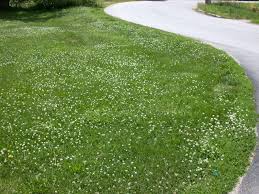
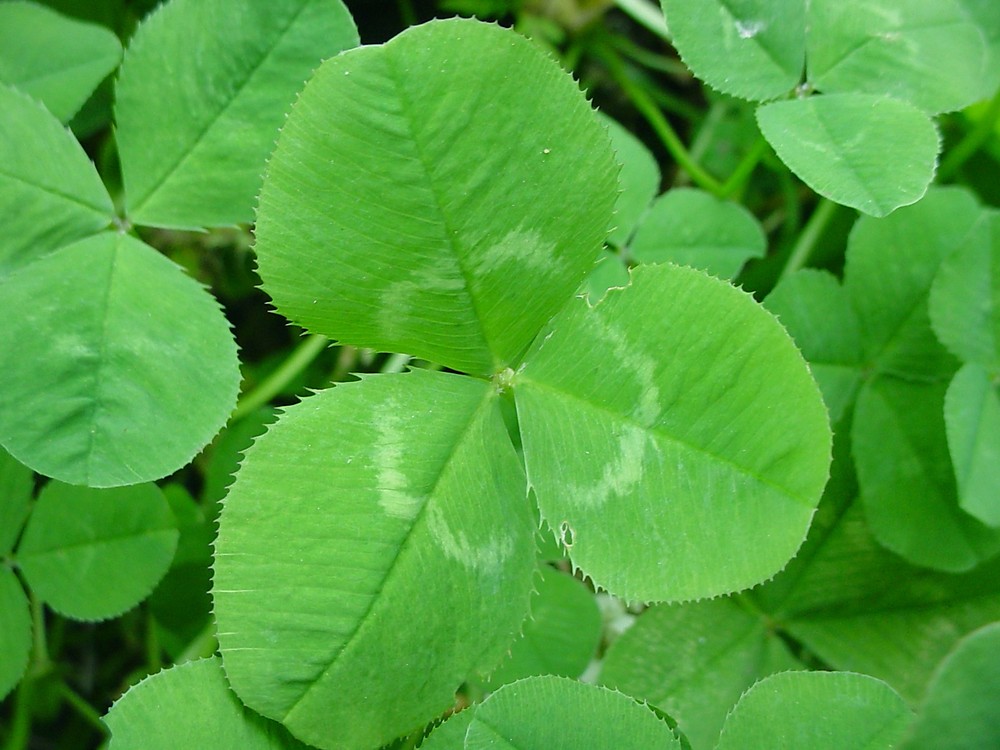
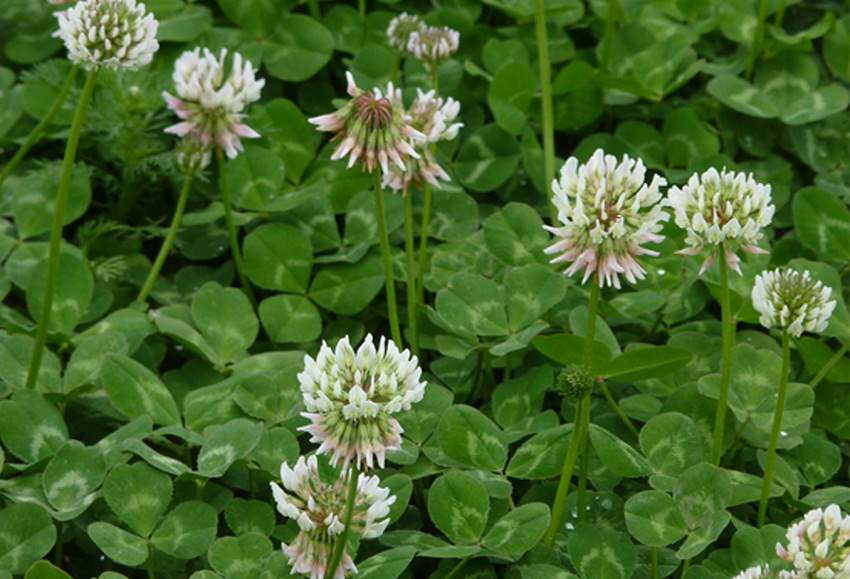
Black Medic
Clover can sometimes be mis-identified, perhaps most commonly as black medic (Medicago lupulina). To add to the confusion, these plants generally grow alongside each other in lawns, especially lawns low in Nitrogen, as both plants are nitrogen-fixing members of the legume family (Fabaceae). The plants of course have distinguishing features. Most notably, the small yellow flowers of black medic form in more tightly packed clusters. Further, the central leaf of black medic is attached to the stem via a petiole that is longer than that of the other two leaves. Finally, black medic leaves lack the white/light-colored arc imprint described above.
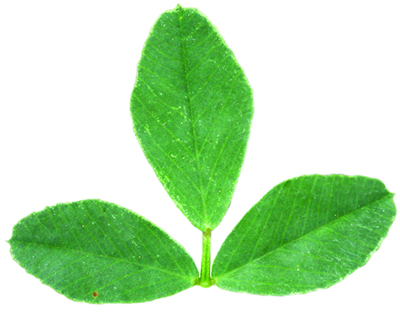
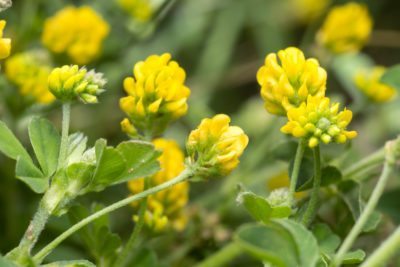
Lucky for you, differentiating these plants isn’t all that critical, as black medic is also a nutrient-packed edible plant. Black medic is high in protein (for a green) but low in fiber. Simply toss the greens into a salad for a fresh kick or lightly saute with olive oil, salt, pepper, and garlic. Cooked, black medic tastes much like spinach. If you’re more patient, germinate the tiny black seeds and enjoy the sprouts in the same way you’d use alfalfa sprouts (my favorite: sprinkle the sprouts on a mozzarella, tomato, basil sandwich drizzled with balsamic vinaigrette).
Wood Sorrel
Both black medic and clover are often confused for various members of the wood sorrel family (Oxalidaceae). Good news is these are also edible! The most common culprit, which grows among the others in a lawn, is common yellow wood sorrel (Oxalis stricta). Common yellow wood sorrel is a perennial (or annual depending on conditions) plant with radially symmetric, 5-petal flowers and heart-shaped trifoliate leaves. To perform photosynthesis the leaves exhibit rhythmic movements in response to light/dark cycles (nyctinasty), curling at dusk and uncurling/flattening at dawn.
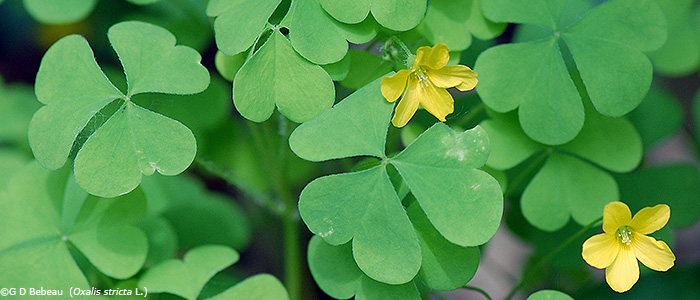
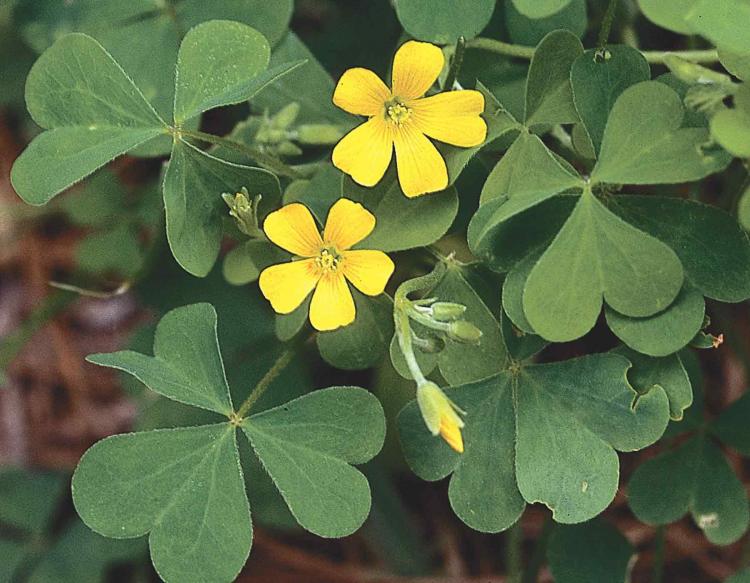
Common yellow wood sorrel has a lemony taste, which explains why some refer to it as sourgrass. Eaten fresh, its tangy taste can quench thirst quite satisfyingly. The pop of flavor can be the perfect little zip to a dull salad. If you’re feeling more adventurous, steep the leaves and stems in boiling water for a lemonade-type drink (see below for recipe courtesy of sarcraft.com). The sour taste comes from oxalic acid, toxic in large doses, so ingest this plant sparingly. If sour tastes are not your bag, then you can still use the plant to make an orange/yellow dye.
We’ll continue next month with dandelion, chickweed, and sheep sorrel. Thanks for reading!
Common Yellow Wood Sorrel Lemonade
Ingredients:
- 1 cup of chopped common yellow wood sorrel (leaves and stems)
- 2 cups of water
- Honey (to taste)
Process: Pour boiling water over the common yellow wood sorrel. Steep for up to 30 minutes. Strain (optional, I like leaving the greens in!). Add honey to taste. Chill and serve. See more here.
Hippie Punch (Adult Beverage with White Clover)
Ingredients:
- 8 oz blackberries
- 8 oz juneberries (or blueberries)
- 1 cup of fresh white clover flowers
- ½ cup of orange juice
- 2 cups of tequila
Process:
Dump the berries into a pitcher and lightly muddle. Add white clover flowers. Pour in the tequila and orange juice. Stir. Add a liberal amount of ice. Add water to adjust the taste to your liking.
Disclaimer
The Philadelphia Orchard Project stresses that you should not consume parts of any wild edible plants, herbs, weeds, trees, or bushes until you have verified with your health professional that they are safe for you. As with any new foods that you wish to try, it is best to introduce them slowly into your diet in small amounts.
The information presented on this website is for informational, reference, and educational purposes only and should not be interpreted as a substitute for diagnosis and treatment by a health care professional. Always consult a health care professional or medical doctor when suffering from any health ailment, disease, illness, or injury, or before attempting any traditional or folk remedies. Keep all plants away from children. As with any natural product, they can be toxic if misused.
To the best of our knowledge, the information contained herein is accurate and we have endeavored to provide sources for any borrowed material. Any testimonials on this web site are based on individual results and do not constitute a warranty of safety or guarantee that you will achieve the same results.
Neither the Philadelphia Orchard Project nor its employees, volunteers, or website contributors may be held liable or responsible for any allergy, illness, or injurious effect that any person or animal may suffer as a result of reliance on the information contained on this website nor as a result of the ingestion or use of any of the plants mentioned herein.
SAFETY PRECAUTION: While there are many plants which are helpful and beneficial for us to partner with, there are plants that are dangerous for us to consume or even to touch. It’s important that we take the necessary precautions – in a city space: avoid harvesting from places with pollution or runoff; avoid harvesting endangered plants; understand there are some plants used medicinally only in small doses vs some that can be eaten with relatively little concern. The most important thing is that you trust your body, go slow with incorporating any new plants into your diet!
SOURCES/MORE INFO:
- Backyard Foraging by Ellen Zachos
- White Clover
- Black Medic
- Common Yellow Wood Sorrel
This POP Blog Post was written by 2019 POP Orchard Intern Chris Flounders.
SUPPORT US! If you found this entry useful, informative, or inspiring, please consider a donation of any size to help POP in planting and supporting community orchards in Philadelphia: phillyorchards.org/donate.